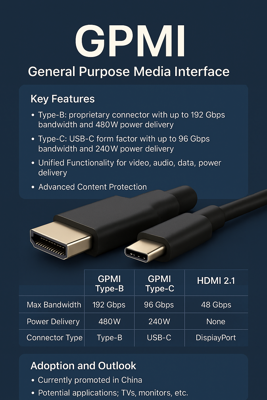
GPMI (General Purpose Media Interface) is a new high-performance digital interface developed primarily by a consortium of over 50 Chinese companies, including Huawei, Hisense, and TCL. It is intended as a superior alternative to existing technologies like HDMI, DisplayPort, and Thunderbolt, offering higher bandwidth, higher power delivery, and advanced content protection.
Type-C:
Bandwidth Capabilities:
Far exceeds HDMI 2.1 (48 Gbps) and DisplayPort 2.1 (80 Gbps).
Power Delivery:
Capable of powering high-performance monitors, TVs, and laptops without separate power cables.
Unified Functionality:
Simplifies device connectivity and reduces cable clutter.
Advanced Content Protection:
Faster authentication than HDMI’s HDCP.
Sideband Communication:
| Feature | GPMI Type-B | GPMI Type-C | HDMI 2.1 | DisplayPort 2.1 | Thunderbolt 4 | USB4 |
|---|---|---|---|---|---|---|
| Max Bandwidth | 192 Gbps | 96 Gbps | 48 Gbps | 80 Gbps | 40 Gbps | 40 Gbps |
| Max Power Delivery | 480W | 240W | None | None | 100W | 240W |
| Connector Type | Proprietary | USB-C | HDMI | DisplayPort | USB-C | USB-C |
| Content Protection | ADCP (SM3/SM4) | ADCP (SM3/SM4) | HDCP | HDCP | DRM | DRM |
Supports higher frame rates and resolutions like 8K@120Hz, 10K, and potentially up to 16K.
Higher Power Delivery:
Ability to supply enough power for large devices such as gaming laptops or ultra-wide monitors through a single connection.
Enhanced Security:
National encryption algorithms improve both security and authentication speeds.
Faster Wake-Up and Communication:
Especially useful for 8K and future 16K televisions.
Gaming Laptops and PCs:
Single-cable docking solutions with video, data, and power all in one.
Professional Workstations:
GPMI is initially being promoted within China for local markets.
International Outlook:
Could be seen as a competitor to existing Western standards, especially if licensing costs and integration benefits are favorable.
Future Potential:
Create a customised learning path powered by AI — stay focused, track progress, and earn certificates.
Build Your Learning Path →